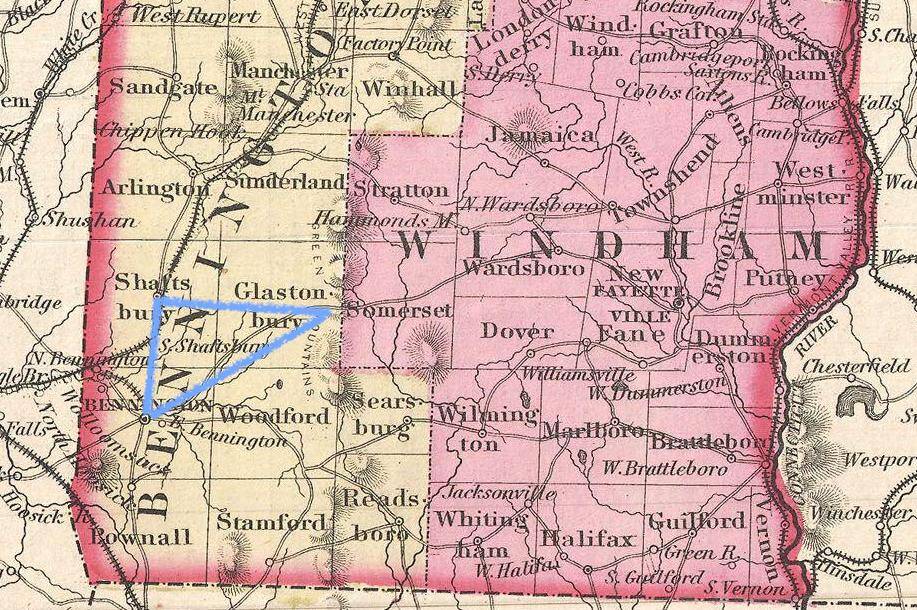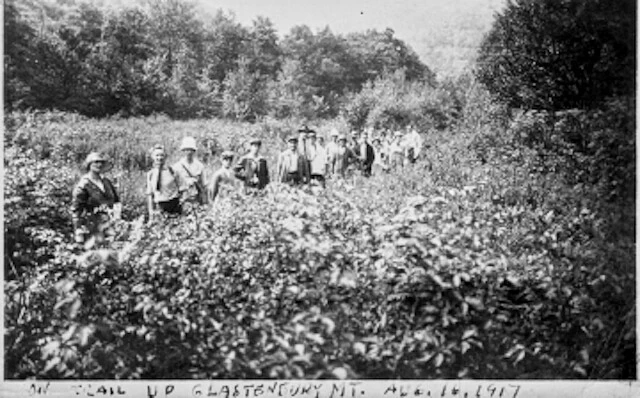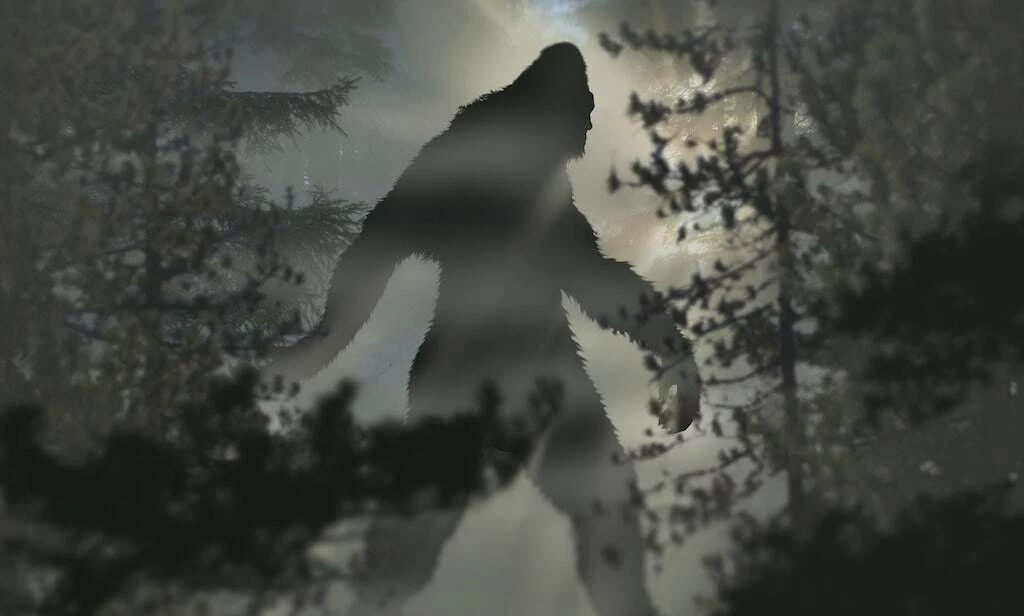The Green Mountain National Forest occupies roughly half of Bennington County, Vermont, with the Glastenbury Mountains in the middle. Between 1943 and 1950, several mysterious disappearances took place in these woods. In 1992, Joseph Citro, a local author on all things ghostly in New England, created the term “The Bennington Triangle” due to some similarities to the Bridgewater Triangle disappearances in Massachusettes. Since then, the Vermont vanishings have become immortalized in the folklore of Bennington’s history.

We have delineated the general area of the Bennington Triangle on this 1855 map of South Vermont.
The Glastenbury Curse
It’s difficult to know where the truth ends and the legends begin about the Bennington Triangle. Even details about the people who have vanished from the area can vary. But one thing most people seem to agree on is that before these disappearances began, Native American tribes held the belief that a curse overshadowed the surrounding woods. With the angry spirits that dwelled in the forest, the tribes stayed away. The only exception was the burial of their dead in the area.
Why the Native Americans ascribed a curse to Glastenbury Mountain is anyone’s guess. Its woods are dark and isolated. By some accounts, it’s also silent, devoid of the usual sounds of nature, such as birds and insects. Many people also attest to ghosts and common hot spots of eerie sensations.
One local Native American legend told of a “man-eating stone.” If someone happened to step on the stone, it would open up and swallow the person. Not surprisingly, some commenters on blog posts say that there are sinkholes strewn about the mountains, which may explain the legend. Another oddity is the Glastenbury cairns, which are man-made piles of rocks that dot the land. Hikers and explorers aren’t quite sure what to make of these.

The caption reads, “On trail up Glastenbury Mountain” Photo 1917.
Glastenbury was mostly uninhabited by European settlers before the 1700s. In 1761, New Hampshire’s governor chartered the town, and by 1791 six families lived in the tiny community. It became a logging town in about 1870, and as many as 240 people called it home. However, overlogging of the mountain by the 1880s decimated the trees and led to the town’s decline. Perhaps the logging damage to the landscape and wildlife caused the Native Americans to believe that the spirits of the forest had become angry. Maybe the Glastenbury curse was something more sinister. Today, only the ruins of Glastenbury ghost town remain with just eight residents.
Disappearances in the Bennington Triangle
-
Carl Herrick
In 1943, Carl Herrick was enjoying a hunting trip with his cousin, Henry, ten miles northeast of Glastenbury town. The two became separated, and Carl never returned. Henry found Carl’s body three days later in a bizarre scene. Carl’s ribs had punctured his lungs, and the postmortem indicated that something had squeezed him to death. Henry reported that there were large bear prints around the corpse. However, experts say a bear would not have squeezed a man to death.
Missing 411: Strange Disappearances in the Wilderness
-
Middie Rivers
This case occurred in 1945. Middie Rivers was a vastly experienced outdoorsman, and few people knew the backwoods better than he did. One day Middie was leading a hunting party in a place called Hell Hollow when he got ahead of the group. The hunters realized that he was no longer with them, but none of the hunters was unduly concerned. They figured Rivers would reunite with them in time. However, no one ever saw or heard from him again.
After a long, thorough search of the area, the only thing anyone found of Rivers was a spent rifle cartridge of the same type he used. No one discovered evidence of an animal attack, and his body is still missing to this day.
-
Paula Welden
Bennington Triangle lore insists that the most famous of all these events was Paula Welden’s disappearance. She was a sophomore student at Bennington University. On the first day in December 1946, the 18-year-old decided to head out for a short hike. So she hitchhiked to the Long Trail in the Glastenbury Mountains in the afternoon.

This picture of Paula Jean Welden circulated during the investigation of her disappearance. Public domain.
Welden’s outfit included a lightweight red jacket that was not ideal for an extended walk. Therefore, many doubt that she intended to be out for very long. A couple that was out for a stroll on Long Trail last saw the teenager approximately 100 yards ahead of them on the path. They watched her as she turned a corner, but when they caught up to the same spot, she was nowhere in sight. Welden’s red jacket would have been hard to miss against the foliage.
When she didn’t show up for class the next day, an extensive search began. The search party consisted of aircraft, over 1,000 people, and the FBI. However, they found absolutely nothing.
More information about Paula Jean Welden’s Disappearance
-
Paul Jephson
Indeed, the most tragic disappearance of the entire flap must be that of 8-year-old Paul Jephson. His mother worked as a caretaker for the local dump. On Columbus Day in 1950, Paul and his mother hopped in the truck and headed to her workplace for a short task. She wasn’t planning to take much time, so she gave Paul strict instructions not to leave the truck. However, when she returned to the vehicle, he was gone.
Just like Paula Welden, Paul wore a bright red jacket that would be very hard to miss among the surrounding forest. Another large-scale search ensued, but nobody in the party found anything. Tracker dogs aided in the search effort to no avail. Like the others, the child vanished off the face of the earth without a trace. Local superstitions include the belief that it is bad luck to wear red while in the forest. Unfortunately, for Welden and Jephson, this appeared to be true.
-
Frieda Langer
In October 1950, Frieda Langer was on a family camping trip at Somerset Reservoir in the Bennington woods. She and her cousin Herbert decided they would take a hike. Less than a quarter of a mile into their trek, Frieda slipped and fell into a stream.
They weren’t far from camp, so Frieda decided she would go back to change her wet clothes and shoes. Herbert waited near the stream for her to return. However, she never showed up. When Herbert returned to camp, he was alarmed to learn that she never made it back at all.
Frieda’s disappearance, such a short distance away, defied most explanations. Local authorities launched a series of searches. For several weeks, the woods became a source of intense scrutiny.
The Bizarre Disappearance of Keith Reinhard in Silver Plume, Colorado
Although her disappearance was weird, the discovery of her body was even more puzzling. Her body turned up seven months after she vanished. However, it was in an open field near the reservoir — an area that authorities had searched on more than one occasion.
Unfortunately, Frieda’s corpse was already in an advanced state of decomposition, and the cause of death was undeterminable. Local law enforcement still has no idea what happened to Langer during her absence.
-
James Tedford
Although the case of James Tedford (also Tetford), was not a disappearance in the woods, as far as we know, it is still mysterious. Tedford was a veteran of the Second World War. In 1949, he was returning to the Soldiers’ Home in Bennington after a visit with some family in St. Albans. Tedford was traveling by public bus and was just one of 14 passengers that were on board when the bus left St. Albans. When the bus arrived at Bennington, he wasn’t on board. However, his luggage was in the rack, and his personal effects – including an unfolded timetable – remained in his seat. It appeared that Tedford had gotten up out of his place and disembarked without anyone else noticing.
Local authorities were not able to do much apart from question those on board. Every possible witness reiterated the same story; Tedford was on the bus when it departed the previously scheduled stop, but not when it pulled into Bennington.
Zone of Silence: Anomalies in the Mexican Desert
Investigators were eager to solve this puzzle as quickly and routinely as possible. One idea was that the man had simply not boarded in the first place. If that was the case, why were his luggage and other effects on the bus? Some people speculate that he saw a friend at the stop before Bennington town and got off to talk to the person. Cool Interesting Stuff wrote that Tedford’s wife had vanished without a trace from his home a few years prior to his own disappearance. When he returned from the war, she was gone. Consequently, perhaps he was suffering from mental health issues.
Theories About the Bennington Triangle
-
Weather Patterns
There are mountaineers and professional hikers who insist that the root of the Bennington Triangle folklore is nothing more sinister than the weather. They suggest that sudden local wind patterns on the mountainside can be erratic and changeable. Even those very familiar with the area could suddenly suffer from disorientation. Such an explanation could account for some of the disappearances, but not all.
-
The Bennington Monster
Some firmly believe that the real cause of the trouble is a much more supernatural one. For two centuries, reports suggested that the woods are home to the Bennington Monster, something like Bigfoot.

Bigfoot is often implicated in any mysterious event in the woods. Free use, Steve Baxter from Pexels.
One story indicates that the driver of a stagecoach and its passengers reported a sighting of the hairy beast in the early 1800s. A sudden downpour caused them to pull the coach over, as the road had washed out. While they waited for the rain to stop, the driver noticed enormous footprints in the mud. He went to ask one of the passengers what he thought when the other passengers on board saw a large hairy creature that ‘had no footwear.’ The beast pushed the coach over onto its side and ran away into the woods.
Wisconsin Sightings of the Beast of Bray Road
-
The Wildman
Another odd character entered Bennington folklore in 1892. A man working at the sawmill in Glastenbury hit another man over the head with a rock and killed the other man. The authorities caught the killer and put him in an insane asylum. However, he escaped. Rumors spread that the killer had gone to live in the mountains and became a hairy deranged Wildman. Some stories say he would, at times, travel down from the wilderness and expose himself to the women in Bennington and Glastenbury towns.
Nevada Triangle: Steve Fossett Mystery
Most historians doubt that Wildman McDowell could be responsible for the disappearances. By the mid-1900s, he would have been a much older man. Nonetheless, the Wildman and the Bennington Monster seemed to have merged in the folklore as one creature or person.
-
Cougars
Many hikers and hunters report cougar sightings in the area. These big cats can stalk hikers for long distances and may wait for an opportune moment to strike. People out by themselves are most at risk, especially during times when the mountain lions’ natural prey is scarce. Because they can weigh more than 200 pounds, a powerful cougar can subdue and kill someone very quickly.

Could cougars have something to do with the disappearances in Bennington? CC2.0 Malcolm.
The Eerie Woods of Bennington
The weather, cougars, a wild man, or a hairy monster are the main theories behind the Bennington Triangle. Some fringe theorists insist that aliens played a part in the disappearances and talk about UFO sightings or portals to another world. Then there are those who assure us it wasn’t anything supernatural. But whatever happened, the world is now very familiar with Bennington, and the people who travel into the Glastenbury woods swear to its profound eeriness.
Sources:
Legends of America
The Maelstrom
Obscure Vermont
Books by Pratt